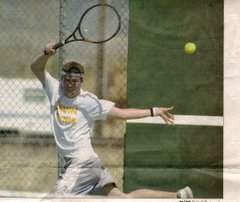The Power of a Mission Statement
As much as it pained Martina Hingis to lose, she couldn't help but do so sometimes. Especially late in her career(s), losing was something that came along with her game. The problem for Hingis, however, was that her mission statement was too short, too simple. The abridged version read something like this: "Win tennis matches."
Hingis' statement is similar to many top-tier players. Actually, it would be hard to find a tennis player at any level that didn't have "winning" somewhere in their mission statement. For the most part, that word would land in sentence one or two, as the forefront goal of a player.
The important part of any mission statement - whether its for a corporation, non-profit, stay-at-home mom or professional athlete - isn't about the end goal, but the process it takes to reach that goal. How, exactly, are you going to reach this stated goal? How are you going to achieve your mission?
If you were to read the unabridged version of Hingis' game, it might go like this: "Win tennis matches by out-thinking opponents." Okay, that's a little better, but still, where is the fuel that feeds the fire?
Let's take men's tennis current number one, Roger Federer. Federer's mission statement might read: "Win tennis matches by out-thinking opponents with the use of tactical slice, a powerful serve, cat-like movement and defense that looks like offense. Achieve this by surrounding myself with positive, confident people who boost my morale, but also keep me grounded. Train under a regimented schedule that challenges both my tennis game and my physique, especially focusing on long-term conditioning."
Federer's mission statement is obviously more detailed, and more goal-oriented. The problem with Hingis throughout her career was that she stuck to her simple mission statement, instead of being willing to change it up with an off-court conditioning program or a beefy serve.
History shows that those willing to re-write their mission statements have been most successful. In 2001, Jennifer Capriati entered the Australian Open shedding her old mission statement ("Hit every ball as hard as possible") with a new one: "Hit every ball as hard as possible and run down every ball hit to me. Do this with a stringent off-court training schedule."
Looking at the players of today, I see mission statement as brilliant as Federer's and as ignorant as Hingis'. The point is, unless there is context behind a great player, they no longer will be able to find success like great champions once did.
Just last week, Pete Sampras, during his well-documented tour with Roger Federer, said that the serve-and-volley game was extinct, and that players were now being taught to hit the ball as hard as they could, simply put.
While Sampras' words ring true, he may want to look at the track record of the last two years in tennis, when players liked Federer, Justine Henin, Rafael Nadal and Serena Williams ruled. Sure, they all hit the ball hard, but it's the substance in their strokes - and their statements - that give them the edge to be the best.

2 comments:
Clicking Here bags replica ysl site link replica louis vuitton visit the site luxury replica bags
t0r51q4l05 k4u81u5n45 u2c11v9n35 b1k91s1j20 g9b06q2v69 z7z17i7w28
Post a Comment